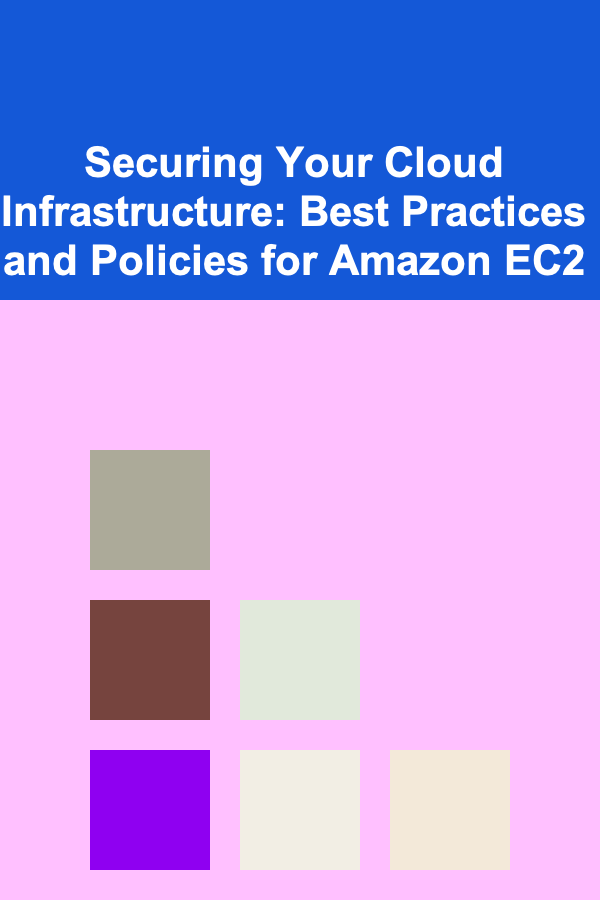
How to Use Cleaning Supplies Efficiently to Cut Costs
ebook include PDF & Audio bundle (Micro Guide)
$12.99$9.99
Limited Time Offer! Order within the next:

Cleaning supplies are essential in both residential and commercial spaces to maintain cleanliness, hygiene, and a pleasant environment. However, the cost of these supplies can quickly add up, especially if they are not used efficiently. Whether you're managing a home, office, or facility, using cleaning supplies in an optimized way can significantly reduce your expenses while ensuring a clean and healthy environment. This guide will explore practical strategies and tips for using cleaning supplies efficiently to cut costs, without compromising on quality.
Understand the Types of Cleaning Supplies You Need
Before jumping into cost-saving techniques, it's important to first understand the different types of cleaning supplies available and their purposes. Not all cleaning products are necessary, and using the right ones for specific tasks can save both money and time.
Key Categories of Cleaning Supplies:
- Surface Cleaners: These include all-purpose cleaners, degreasers, and specialized surface cleaners for different materials such as wood, glass, or stainless steel.
- Disinfectants: These are used to kill germs and bacteria on surfaces. They are especially important in high-touch areas such as doorknobs, switches, and bathroom surfaces.
- Floor Cleaners: Depending on your flooring type (wood, tile, carpet), there are specific cleaners designed to protect the surface while cleaning it effectively.
- Cleaning Cloths and Sponges: The cleaning tools you use can impact how effectively and efficiently you use your cleaning supplies. High-quality cloths or reusable sponges can save on disposable wipes and paper towels.
Tip: Assess Your Needs
Evaluate the specific needs of your space. Do you need all-purpose cleaners for regular maintenance or specialized products for stubborn stains? By selecting only what is truly necessary, you can avoid overspending on unnecessary products.
Stock Up on Bulk Purchases
One of the most effective ways to reduce the per-use cost of cleaning supplies is to buy them in bulk. Many cleaning products are packaged in large quantities that cost less per unit than smaller packages.
Why Bulk Purchasing Helps:
- Lower Unit Cost: Bulk products, such as large bottles of all-purpose cleaners or large packs of microfiber cloths, cost less per unit than buying smaller sizes.
- Fewer Restocks: When you buy in bulk, you'll need to restock less frequently, reducing the number of trips to the store and the chances of running out of supplies unexpectedly.
- Better Stock Management: By keeping a larger supply, you can better manage how much you're using and avoid waste.
Tip: Check Product Shelf Life
Be mindful of the shelf life of cleaning supplies, especially for products like disinfectants, which may lose effectiveness over time. Buying in bulk only makes sense if you can use the products before they expire.
Proper Dilution of Cleaning Products
Many cleaning products are highly concentrated, and using them without dilution can lead to unnecessary waste and higher costs. By following the recommended dilution ratios, you can make your cleaning supplies last much longer.
How to Dilute Products Properly:
- Follow Manufacturer Instructions: Always check the label for dilution instructions. Some cleaners, like concentrated floor or surface cleaners, may need to be mixed with water before use.
- Use Measuring Tools: Invest in a small measuring cup or bottle with clear measurements to avoid overusing cleaning products. For example, using a capful of cleaner for a gallon of water is often sufficient for large cleaning jobs.
- Dilution Saves Money: For instance, a high-quality all-purpose cleaner might cost more upfront, but diluting it correctly can provide several more uses than you'd expect from a ready-to-use bottle.
Tip: Invest in a Spray Bottle
For products that need to be diluted, use a spray bottle to mix the solution. This allows you to apply only the necessary amount, reducing waste and ensuring efficient usage.
Maintain Your Cleaning Tools
Cleaning tools like mops, brushes, cloths, and vacuum filters play a significant role in the effectiveness of your cleaning efforts. Keeping these tools in good condition helps them work more efficiently, reducing the need for additional cleaning supplies.
How to Maintain Your Cleaning Tools:
- Wash Microfiber Cloths Regularly: Microfiber cloths are reusable, but they need to be cleaned and maintained to keep their effectiveness. Wash them regularly to avoid the buildup of dirt, which can cause you to use more cleaning product than necessary.
- Empty Vacuum Bags or Bins Often: If you're using a vacuum cleaner, be sure to empty the bag or bin regularly. A full vacuum reduces suction power, meaning you'll have to clean longer and more frequently.
- Replace Worn Brushes or Mops: Brushes or mops that are worn out or dirty can make cleaning less efficient and more labor-intensive. Replace them as needed to keep cleaning quick and easy.
Tip: Use Reusable Mops and Cloths
Instead of using disposable wipes and mop pads, which contribute to ongoing costs, use washable, reusable alternatives. This is an easy way to reduce waste and save money.
Reduce the Frequency of Cleaning in Low-Traffic Areas
Not all areas need to be cleaned at the same frequency. Some areas, such as bathrooms or kitchens, require daily or weekly cleaning, while others, like guest rooms or offices, may only need to be cleaned bi-weekly or monthly.
How to Optimize Cleaning Frequency:
- Prioritize High-Traffic Areas: Focus your cleaning efforts on areas that see the most use. For instance, clean high-touch surfaces in the kitchen and bathroom more frequently, but leave other less-used areas for occasional cleaning.
- Don't Overclean: While keeping your space clean is important, cleaning less frequently in areas that aren't as prone to dirt or germs can save supplies. For example, you don't need to wash windows weekly if they're not exposed to much dirt.
Tip: Adopt a Cleaning Schedule
Create a cleaning schedule based on the specific needs of each area in your home or business. This way, you avoid cleaning areas unnecessarily, helping you stretch your cleaning supplies and reduce costs.
Use Eco-Friendly, Homemade Cleaning Solutions
In addition to traditional commercial cleaners, eco-friendly, homemade cleaning solutions can save money while being effective for many tasks. Many household items such as vinegar, baking soda, and lemon can be used to clean and disinfect surfaces without the need for expensive, chemical-laden cleaners.
Effective Homemade Solutions:
- Vinegar and Water: A solution of equal parts vinegar and water can clean windows, mirrors, countertops, and floors without harsh chemicals. The acidity of vinegar helps break down grease and grime.
- Baking Soda Paste: For tough stains on surfaces like stovetops, sinks, or bathtubs, a paste of baking soda and water can work wonders.
- Lemon Juice: Lemon juice is great for its disinfectant properties and pleasant scent. It's also effective at removing hard water stains and brightening whites in laundry.
Tip: Test Before Full Use
While homemade solutions are often safe, always test them on a small, inconspicuous area first to ensure they don't damage surfaces.
Store Your Supplies Properly
Proper storage of your cleaning supplies can extend their shelf life and reduce waste. Many cleaning products lose their effectiveness if stored improperly, which means you may end up using more than you actually need.
Storage Tips:
- Avoid Direct Sunlight: Store cleaning products in a cool, dry place, away from direct sunlight. Sunlight can degrade many cleaning solutions, reducing their effectiveness.
- Seal Containers: Ensure that all products are tightly sealed to prevent them from evaporating or spilling.
- Organize Your Supplies: Keeping your cleaning supplies organized and easily accessible will ensure that you don't accidentally buy products you already have. It can also help you avoid overusing supplies because you know exactly what you have.
Tip: Use Clear Storage Containers
Use clear bins or labeled bottles to keep track of your cleaning products and their quantities. This can help you avoid buying duplicates or running out of supplies unexpectedly.
Buy Generic Brands
In many cases, generic or store-brand cleaning products perform just as well as name-brand options but at a fraction of the cost. These products often contain the same active ingredients but come at a lower price due to less expensive packaging and marketing.
Why Generic Brands Work:
- Comparable Effectiveness: Store brands often perform just as well as the big-name brands. For basic cleaning tasks, you can save significantly by switching to generic alternatives.
- Availability: Generic cleaning products are readily available in most stores and can be an easy substitute for higher-priced brands.
Tip: Read Product Labels
Ensure that the generic cleaning products meet your specific needs. Sometimes, higher-priced brands may offer unique features like scent options or specialized formulas, so it's worth comparing options.
Conclusion
Efficiently using cleaning supplies to cut costs requires a combination of strategic buying, smart usage, and proper maintenance. By understanding your needs, buying in bulk, using products correctly, maintaining your tools, and exploring cost-effective alternatives, you can dramatically reduce your cleaning expenses without sacrificing cleanliness or hygiene. Adopting these practices will not only help you save money but also promote a more sustainable and effective cleaning routine.

How to Maintain an Organized Workspace for Remote Work
Read More
How to Organize Your Bathroom for Stress-Free Mornings
Read More
How to Organize Your Phone Apps for Clutter-Free Navigation
Read More
How to Overcome Common Challenges When Implementing Augmented Reality (AR) in Your Dropshipping Store
Read More
How to Soundproof Your Home Theater Room for the Best Experience
Read More
Securing Your Cloud Infrastructure: Best Practices and Policies for Amazon EC2
Read MoreOther Products

How to Maintain an Organized Workspace for Remote Work
Read More
How to Organize Your Bathroom for Stress-Free Mornings
Read More
How to Organize Your Phone Apps for Clutter-Free Navigation
Read More
How to Overcome Common Challenges When Implementing Augmented Reality (AR) in Your Dropshipping Store
Read More
How to Soundproof Your Home Theater Room for the Best Experience
Read More